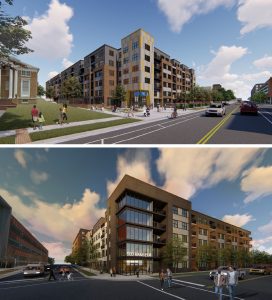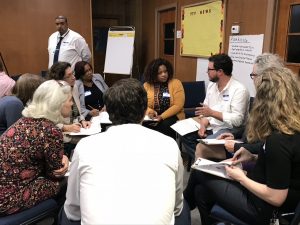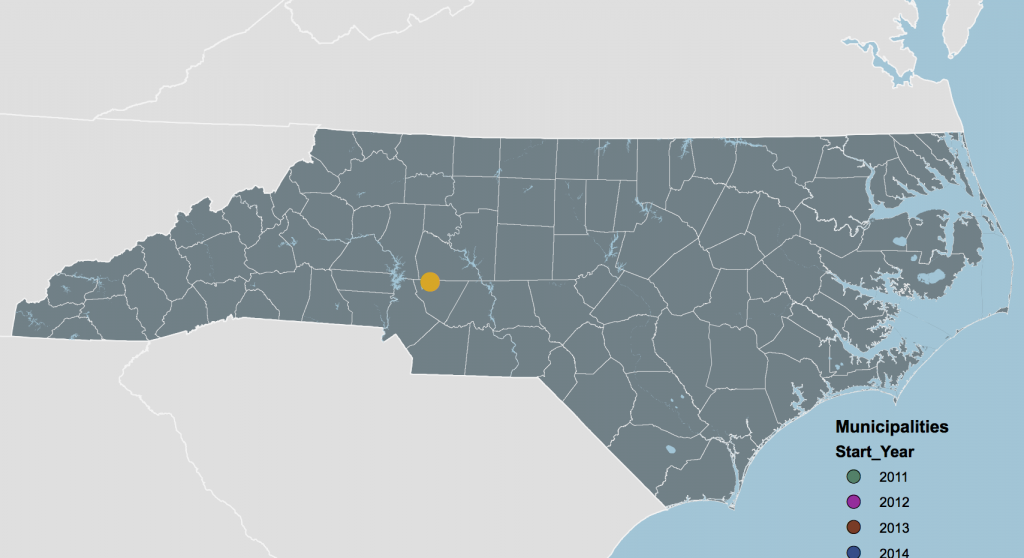A Place For All Our People (Durham, NC)
A PLACE FOR ALL OUR PEOPLE
With guidance from the UNC School of Government and its Development Finance Initiative (DFI), the county of Durham pursues sustainable development downtown.
By Mary Lide Parker
Gentrification. Affordable housing. Mixed-use development. As cities across the country experience revitalization, these buzzwords have become more and more commonplace in conversations about urban development.

Durham is no exception.
“What is happening in Durham is happening all over the country,” said Wendy Jacobs, chair of the Durham Board of County Commissioners. “With revitalization of downtown areas, we are seeing a lot of economic opportunity and development. But we’re also seeing the displacement of people who have lived in downtown neighborhoods for many decades. People can no longer afford to live in neighborhoods and homes that they have lived in for generations.”
With new businesses and economic growth comes a major increase in property values. As taxes go up, the number of low and middle-income families drops.
“If we want to have a vibrant, diverse, and inclusive downtown, we have to have places for all kinds of people to live,” Jacobs said.
The idea of affordable housing is simple enough: create homes for low and middle-income families in the downtown area.
“In county government specifically, we have law enforcement, public health workers, social workers, librarians, EMS, and first responders,” Jacobs said. “All these people work in downtown Durham and they should be able to live where they work.”
Making those homes a reality, however, is a bit more complicated.
Recognizing the Challenge
In the last four to five years, downtown Durham (the largest neighborhood in the county) has seen a significant surge in development.

“We’ve had about three or four thousand residential units added during that period of time,” said Wib Gulley, a former mayor and North Carolina state senator.
“Downtown is also the most expensive neighborhood in the county,” Gulley said. “And until very recently, it had zero affordable housing units.”
Gulley volunteers with an organization called the Coalition for Affordable Housing and Transit, commonly known around Durham as “the Coalition.”
“The first thing you learn about affordable housing is, it’s complicated,” Gulley said. “It’s not just people who are homeless getting into temporary shelter, or people transitioning from shelters to permanent housing. It’s not just people who rent, and it’s not just people who want to become first-time homeowners but can’t find anything they can afford. It’s all those scenarios and more.”
Developing affordable housing is a lengthy and complex process. It requires a high level of expertise to navigate the tax credit requirements, lexicon, and many regulations that are unique to affordable housing development.
That’s where the UNC School of Government comes in.
Making it work
As part of the School of Government, the Development Finance Initiative (DFI) partners with local governments to attract private investment to generate transformative projects. The program does this by providing specialized finance knowledge and development expertise.
“DFI helps take a community’s vision and ground it in market and financial realities,” said Sarah Odio, a DFI project manager.
After the Capital Improvement Plan identified the 300 and 500 blocks of downtown Durham as sites for new parking decks, the county commissioners stepped in. “They said, ‘time out—let’s look at doing more on these properties,” said Peri Manns, Deputy Director of Engineering and Environmental Services for Durham County. “They wanted to look at putting some type of affordable housing component on it.’”
It is important to note affordable housing is not limited to public housing. Public housing relies on ongoing federal funding and is publicly managed by local housing authorities, while private affordable housing leverages private investment and typically operates independently from local governments.
DFI’s approach to pre-development involves several steps: community engagement, a parcel analysis to understand current conditions in downtown, a site-specific market analysis, site planning, and financial feasibility. Ultimately, DFI’s goal is to identify a project that meets the public interests and “works” for a private developer.
“Public sector and private sector people sometimes have a difficult time communicating,” Odio said. “So, we sit at the table to help translate and make sure public interests are protected. We also help local governments understand the real constraints faced by the private sector. In the end, we want to create a project that works for everyone.
“The biggest issue is navigating the regulatory requirements around affordable housing and all the various laws regarding tax credits,” Manns said. “Since the County does not traditionally invest in affordable housing, we did not have a true understanding of what’s required, and that’s why it was so critical to get DFI on board—it has been a huge learning experience.”
Mitigating uncertainty for the developer, making sure the specifics of the project are clear, and gaining input from the community are some of DFI’s major priorities. “Our work doesn’t just benefit the County,” Odio said. “It’s also providing the developers with clear expectations, saving them time, and giving them a vision to create projects with a real impact.”
Bridging the Knowledge Gap
“This was our first affordable housing project and we didn’t have the experience or the bandwidth to pull off all the leg work on our own,” Manns said. “DFI has the expertise to do the necessary analysis and the due diligence to see if this will be a viable project for a developer.”
DFI lays all the cards on the table for potential developers through a solicitation document that summarizes all of DFI’s prior pre-development work. Developers submit proposals to the County in hopes of being selected as a future partner for the project.
“The solicitation process clearly lays out the County’s expectations for its future partner,” said Marcia Perritt, associate director at DFI. “We had a lot of developers do extra leg work to impress the County. When the basic elements of the deal are unambiguous, developers can take the time to create relationships with community stakeholders and take these projects to the next level.”
“We had multiple developers who took the time to establish relationships with local organizations, such as daycare providers and grocers,” Odio said. “Some developers even found local investors that would support the project. There is huge value to that.”
Advocating for the Community
“Cities usually pursue affordable housing,” Odio said. “But the County and City of Durham tend to work together more cooperatively—their boundaries are closer, and it’s more of an urban county.”
“We’re incredibly fortunate in North Carolina to have an institution like the UNC School of Government and DFI,” Jacobs said. “We’re using this new ability to do public/private partnerships, and we needed the outside expertise to navigate that and understand what we can and cannot do.”
Engaging with the people of Durham was a critical part of the process as well, according to Jacobs. “Through the process that DFI created, we were able to hear directly from the community and identify the most important priorities based on the feedback we got.”
“When you’re engaged with a developer and a private partner, it’s important to have a non-profit who has your best interests at heart,” she said. “DFI is there to help local governments make good decisions that are going to benefit our communities. That’s really essential.”
Looking toward the future
Throughout his decades of public service, Wib Gulley has seen many different consultants work with local public governments around the issue of affordable housing. “There have been a number of times when, frankly, I don’t think they’ve done a very good job,” he said. “But DFI has been impressive—by far the best job of engaging with the community, developing options for the county to consider, and managing a rigorous process to select a development partner.”
Like many people who advocate for affordable housing in Durham, Gulley is excited to see the 300/500 East Main Redevelopment become a reality.
“This is going to more than triple the amount of affordable rental housing in downtown Durham,” he said. “I don’t want to suggest that the problem is solved—we still have quite a way to go—but the County commissioners’ commitment to making this a priority is big step forward.”
The completion of the Main Street developments will certainly represent a more inclusive and diverse downtown, but it may also serve as a framework for creating more affordable housing options across the entire county of Durham.
“What we have learned is that every neighborhood in an urban community should have its share of affordable housing,” Gulley said.
When considering the future of Durham (and cities like it), Gulley hopes to see every neighborhood offers a range of housing options. “The dream scenario would be for people to pick any neighborhood they want,” he said. “And find affordable options regardless of what walk of life they come from.”



